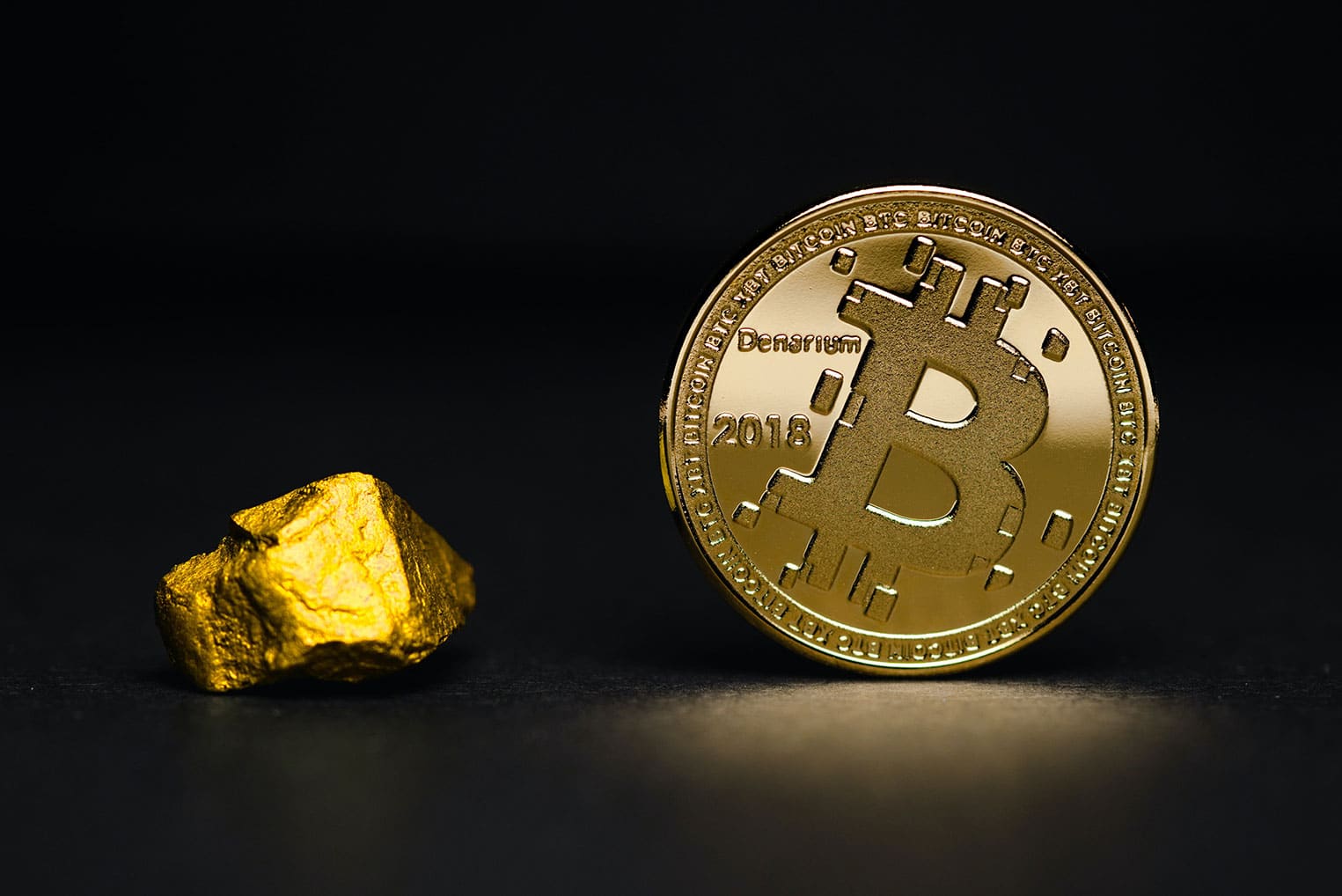
30 Jan Gold versus Bitcoin 2021: adding to the debate
As published in the Business Maverick on 30 January, 2021 by Kyle Wales
However, the performance of gold has been completely overshadowed by Bitcoin which is also held to be a safe-haven asset by its adherents. Bitcoin had already risen by 27% YTD by 30 June 2020 and had risen an eye-watering 305% YTD by 31 December 2020. By comparison gold had risen 17% YTD by June 20 but only 25% by 31 December 2020.
That gold is a safe-haven asset is accepted by most investors but whether Bitcoin is a safe-haven asset is an assertion that is far more contentious. In this article I will attempt to make my own contribution to that debate.
Firstly, a necessary distinction must be drawn between a monetary asset and safe-haven asset. “Money” performs three primary functions, which are: (1) a medium of exchange, (2) a unit of account and (3) a store of value. Fiat money continues to perform the first two roles pretty well and it is only in the third role, as a “store of value”, that loose monetary policy has debased fiat money, allowing gold or Bitcoin to emerge (or “re-emerge”, as the case may be) as substitutes. My discussion will therefore focus on gold and Bitcoin as safe-haven assets or “stores of value” rather than as monetary assets more generally.
The primary arguments I have seen presented as to why Bitcoin is preferable to gold are the following. I will try to address each argument individually:
- Widespread acceptance
- Scarcity
- Physical constraints of gold
- Anonymity and risk of confiscation
Widespread acceptance.
While Bitcoin has only been around for 13 years, gold has been entrenched as a safe-haven asset for thousands of years (). The argument presented in favour of Bitcoin is that the rate of adoption of Bitcoin as a safe-haven asset has been expanding and this may have significant implications for the price of Bitcoin going forward. The “market cap” of all the Bitcoin in circulation is under $700 billion (18.5 million Bitcoin at a price of $ 37,000 as at 7 January 2021) versus gold which has a “market cap” of $9 trillion. There is clearly still a lot of potential for the “market cap” of all the Bitcoin in circulation to grow if its acceptability approaches (or exceeds) gold.
Further bolstering this argument, is the fact that Bitcoin’s popularity as a safe-haven asset should also increase as generational wealth is passed from Baby-boomer generation to Millennial generation, because its popularity as a safe-haven asset amongst this group even exceeds gold. However, I would argue that Bitcoin’s current popularity amongst Millennials may largely be attributed to how successful it has been as a speculative asset in the recent past. The Millennial generation is still firmly in the wealth accumulation phase of their financial life cycle (rather than the wealth preservation phase) and part of what makes Bitcoin desirable is that it offers the ability to “get rich quick”. In this case I would draw clear parallels today between Bitcoin today and Joseph Kennedy’s assertion that a great sell signal to exit the stock market in 1929 was when “shoeshine boys started giving him stock tips”!
Scarcity
Adherents of Bitcoin often point to the fact that only 21 million Bitcoin can be manufactured (as at 7 January 2021, 18.4 million have been mined to date and it can take up to 120 years to mine the remaining 2.5 million) as one of their key arguments why Bitcoin trumps gold. They argue that there is no cap on the supply of gold that can be mined. In my view this argument is too simplistic. While it is irrefutable that the supply of gold in the world is increasing every year, it is doing so at a very low rate (at only 1.5% p.a. according to the World Gold Council) and the cost of extracting gold is increasing all the time which means the price of gold has increase to incentivise miners to extract more of it.
In addition, gold is still a very scarce resource if one considers the amount of it that has ever been mined. The World Gold Council estimates that if all the gold ever mined in history was stacked on a standard rugby pitch (106m long by 68 metres wide) it would form a pile only 1.5 metres high.
Finally, if one evaluates the scarcity of Bitcoin – not just on the amount of Bitcoin itself in circulation but on the amount of cryptocurrencies more generally – the proliferation of alternative coins (or “alt coins” as they are sometimes called) may pose a problem. This is especially true if one considers that these coins came into existence later than Bitcoin and may hold certain advantages over Bitcoin itself.
Physical constraints of gold
Perhaps the most popular argument that has been presented in favour of Bitcoin is that gold, because it is a physical asset, falls prey to certain weaknesses which Bitcoin as a digital asset doesn’t. These include portability, tradability and the fact that gold needs to be physically stored.
These arguments presuppose that the only way to hold gold is to hold physical gold. This is not the case and hasn’t been the case for a while. The bulk of gold is held in form of ETFs (exchange traded funds) which are highly liquid and infinitely portable, hence removing the first two obstacles.
The only obstacle with respect to gold being a physical asset that cannot be overcome is the fact that it needs to be stored physically. Most gold ETFs have physical bullion backing them and there is a cost attached to this.
SPDR Gold, the world’s largest gold ETF, which held $74bn dollars in gold as at 7 January 2021, had a total expense ratio of only 0.4% which incorporated all the storage costs of gold backing its holdings. I will explain later on while this cost may pale in comparison with some of the less well advertised costs associated with holding Bitcoin.
Anonymity and risk of confiscation
One of the original intentions of Bitcoin founders was to create a form of money that was totally anonymous. With fiat money, the involvement of intermediaries such as banks meant that the two parties to a transaction could be identified when they transacted digitally (although they could still transact anonymously if they transacted physically). With Bitcoin, the two parties to a transaction could remain anonymous even if they chose to transact digitally by transacting directly and limiting their means of identification to their public keys. This gives no indication whom the beneficial holders are. This is not only helpful to people engaged in criminal activities, but to all participants in the Bitcoin network because it reduces the risk of central authorities (like the governments) confiscating their Bitcoin if they chose to do so.
The confiscation of safe-haven assets like gold has happened in the past so this risk should not be ignored. An example would be executive order 6102 issued by President Roosevelt in 1933 which forbade “the hoarding of gold coin, gold bullion, and gold certificates within the continental United States” and forced citizens to sell their gold to the government at below-market rates. Gold ownership remained illegal in the US until the 1970’s.
In theory, trading anonymity is undoubtedly an attractive feature of Bitcoin but many Bitcoin holders have reintroduced intermediaries into the Bitcoin value chain by using Bitcoin exchanges, and this reveals beneficial ownership to regulators, leaving Bitcoin investors much the same position as those who invest in gold.
Bitcoin is not without its disadvantages
As shown above, while I think that rebuttals can be supplied for some of the arguments that Bitcoin adherents have supplied for holding Bitcoin, it has a number of additional disadvantages relative to gold which impair its value as a safe-haven asset.
- Regular asset or quasi-currency. This is a very important distinction. Bitcoin, like gold has very little intrinsic value. Therefore, the only way one can hope to a place a value on it (no matter how tenuous) is if one accepts its role as a safe-haven asset, which will allow it to step into the role of a banking fractional “reserve”. If one does not accept its role as a banking fractional “reserve”, its essence becomes more akin to a Picasso painting i.e. more prone to wild swings (depending on the popularity of Picasso at any given point in time) and not a safe-haven asset by definition.
The concept of a banking fractional “reserve” harks back to the days when the world used the gold standard. In those days banks had to keep a certain % of the gold they took from deposits as fractional “reserves” in their vaults. Their reason for doing so was to prevent a “run on the bank” if a large proportion of depositors sought to withdraw their gold at the same time and they were unable to honour their claims. The ratio of gold to deposits that banks used to hold as a fractional “reserve” was roughly 10%.
If one assumes that “fiat” currency becomes so debased that something similar to a gold standard has to be restored, it is not a stretch to say that banks would have to hold an equivalent % of that substance as a fractional banking “reserve”. According to the World Bank there is roughly $135 trillion of broad money in circulation so the value of the safe-haven underpinning broad money supply would have to be $13.5 trillion to fulfil this role. The combined market cap of Bitcoin plus gold today is roughly $10 trillion ($9 trillion + $700 billion) which points to the fact that there may only be 35% upside to their combined market caps if one assumes that they can both perform the function of a banking fractional reserve. Obviously, the potential upside for Bitcoin with its “market cap” of a mere $700 billion could be far greater than this, especially if it took market share away from gold in this role.
- Volatility. In my view there are three key criteria which an asset has to meet in order to qualify as a safe-haven asset. These are: (1) it has to exhibit low volatility, (2) it has to exhibit a negative correlation with risky assets like the S&P 500 (because it is held as a hedge against the movements in these assets), and (3) it has to act as a hedge against inflation over a sufficiently long period of time. Bitcoin has clearly satisfied the third criterion during the decade it has been in existence, though it does not meet the other two criteria.
- Theft. While the Bitcoin protocol itself is secure, the majority of Bitcoin users transact with Bitcoin using a third-party intermediary such as an exchange. This enables them to transact in Bitcoin more easily. As soon as this is done, (1) the Bitcoin owner either enters into an arrangement with the intermediary in terms of which Bitcoins are held in the exchange’s account and the exchange issues an IOU to the beneficial holder or (2) the exchange provides a digital wallet to the beneficial owner where it acts as the custodian of the beneficial holder’s private key. This is where the weakness enters the chain. Either this introduces credit risk into the equation (in the former case) or it introduces a security vulnerability as the beneficial holder’s private key is only as secure as the systems of the third-party intermediary (in the latter case). Incidentally, the safest way to hold Bitcoin is through “cold storage” where one holds one’s public and private key’s offline on a physical device or paper wallet. This would leave the Bitcoin investor in a very similar position to a person storing (gold) bullion in a vault.
In its “Spring 20 Cryptocurrency Crime and Anti-Money Laundering Report” US cybersecurity firm Cipher Trace estimated that cryptocurrency crime caused losses of $1.4bn in 2020 in terms of hacks, thefts and frauds (or $3.4bn annualized). If one uses the average “market cap” of Bitcoin during 2020 of $200 billion (this assumes an average price of $11,146), the cost of theft, spread amongst all Bitcoin holders, amounts to a substantial 2% annualized. Recall that the costs of storing gold are less than 40bps annualized.
In addition, where Bitcoins are stolen, holders also have no recourse because they become untraceable. Bitcoins, unlike banknotes, do not have a serial numbers. - Whales and their motives. It is estimated that only 2% of Bitcoin accounts hold 93% of Bitcoin, and this makes the Bitcoin market vulnerable to manipulation. In the gold market, there are similarly “whales” (in the case of gold, central banks) which account for a substantial portion of gold holdings, but they account for a smaller portion of the gold market and their primary motivation is not to make a profit off others.
In conclusion, while Bitcoin unquestionably has its devotees, my preference to hold gold as a safe-haven asset remains. Although the meteoric Bitcoin price increases might suggest I’m wrong in my assumptions, I have always chosen the “tried and tested” above what is “ground-breaking but unproven” and I have my suspicions that this may prove to be a character flaw as far as Bitcoin is concerned.
Even after its current rise, Bitcoin has a widening chorus of supporters that are clamouring to purchase more (for now) and this may support the current Bitcoin price and even push it higher.
When it comes to the crux of it, my negativity on Bitcoin arises from the fact that, to use a Buffet aphorism, I feel I am straying outside my “circle of competence” when I try to place a “fair” value on it. However, I am mindful of the fact – to use another Buffet-ism – that “markets can remain irrational longer than one can remain solvent” so it would be very brave (or foolish) for a person to go short.
I am prepared to wait on the sidelines for now.



















